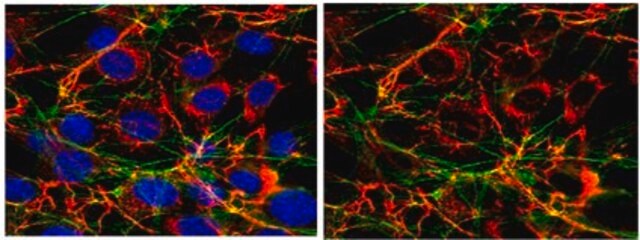MAB1940
Anti-Fibronectin Antibody, cellular, clone DH1
clone DH1, Chemicon®, from mouse
Synonim(y):
Anti-CIG, Anti-ED-B, Anti-FINC, Anti-FN, Anti-FNZ, Anti-GFND, Anti-GFND2, Anti-LETS, Anti-MSF, Anti-SMDCF
About This Item
Polecane produkty
pochodzenie biologiczne
mouse
Poziom jakości
forma przeciwciała
purified antibody
rodzaj przeciwciała
primary antibodies
klon
DH1, monoclonal
reaktywność gatunkowa
rat, guinea pig, human, rabbit
producent / nazwa handlowa
Chemicon®
metody
immunohistochemistry: suitable
western blot: suitable
izotyp
IgG1
numer dostępu UniProt
Warunki transportu
wet ice
docelowa modyfikacja potranslacyjna
unmodified
informacje o genach
human ... FN1(2335)
rabbit ... Fn1(100328589)
rat ... Fn1(25661)
Specyficzność
Immunogen
Zastosowanie
Indirect immunohistochemistry at 1:200-1:400
A 1-hour fixation with 3-3.5% paraformaldehyde in 0.1 M phosphate buffer pH 7.4 is suggested. Shows some reactivity on paraffin sections depending on fixation conditions and time (Latvala et al., 1996).
Final working dilutions must be determined by end user.
Postać fizyczna
Informacje prawne
Not finding the right product?
Try our Narzędzie selektora produktów.
Kod klasy składowania
12 - Non Combustible Liquids
Klasa zagrożenia wodnego (WGK)
WGK 2
Temperatura zapłonu (°F)
Not applicable
Temperatura zapłonu (°C)
Not applicable
Certyfikaty analizy (CoA)
Poszukaj Certyfikaty analizy (CoA), wpisując numer partii/serii produktów. Numery serii i partii można znaleźć na etykiecie produktu po słowach „seria” lub „partia”.
Masz już ten produkt?
Dokumenty związane z niedawno zakupionymi produktami zostały zamieszczone w Bibliotece dokumentów.
Nasz zespół naukowców ma doświadczenie we wszystkich obszarach badań, w tym w naukach przyrodniczych, materiałoznawstwie, syntezie chemicznej, chromatografii, analityce i wielu innych dziedzinach.
Skontaktuj się z zespołem ds. pomocy technicznej








